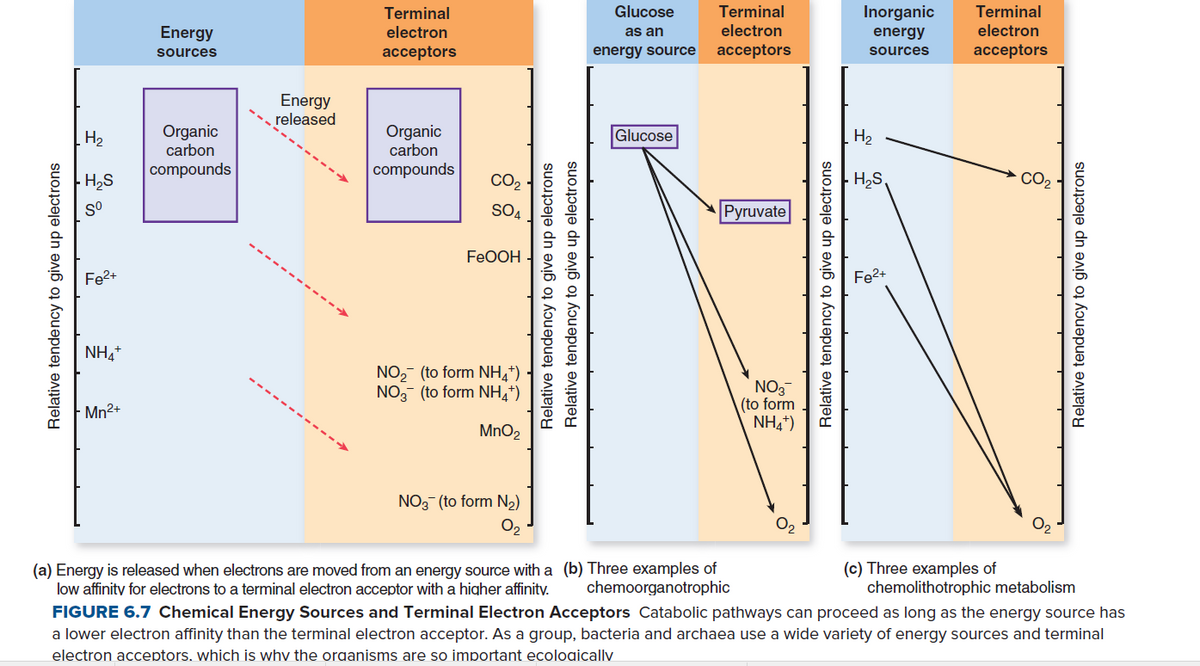Terminal electron Glucose Terminal Inorganic Terminal Energy electron energy electron as an acceptors energy source аcceptors acceptors sources sources Energy released Organic carbon Organic carbon Glucose H2 -------> H2 H2S compounds compounds CO2 H2S, CO2 so SO4 Pyruvate ------------ FEOOH Fe2+ Fe2+ NHẠ NO, (to form NH,*) NO3- (to form NH,*) NO3 (to form NH,*) Mn2+ MnO2 NO3 (to form N2) (a) Energy is released when electrons are moved from an energy source with a (b) Three examples of low affinity for electrons to a terminal electron acceptor with a higher affinity. (c) Three examples of chemolithotrophic metabolism chemoorganotrophic FIGURE 6.7 Chemical Energy Sources and Terminal Electron Acceptors Catabolic pathways can proceed as long as the energy source has a lower electron affinity than the terminal electron acceptor. As a group, bacteria and archaea use a wide variety of energy sources and terminal electron acceptors, which is why the organisms are so important ecoloaicallv Relative tendency to give up electrons Relative tendency to give up electrons Relative tendency to give up electrons Relative tendency to give up electrons Relative tendency to give up electrons
Terminal electron Glucose Terminal Inorganic Terminal Energy electron energy electron as an acceptors energy source аcceptors acceptors sources sources Energy released Organic carbon Organic carbon Glucose H2 -------> H2 H2S compounds compounds CO2 H2S, CO2 so SO4 Pyruvate ------------ FEOOH Fe2+ Fe2+ NHẠ NO, (to form NH,*) NO3- (to form NH,*) NO3 (to form NH,*) Mn2+ MnO2 NO3 (to form N2) (a) Energy is released when electrons are moved from an energy source with a (b) Three examples of low affinity for electrons to a terminal electron acceptor with a higher affinity. (c) Three examples of chemolithotrophic metabolism chemoorganotrophic FIGURE 6.7 Chemical Energy Sources and Terminal Electron Acceptors Catabolic pathways can proceed as long as the energy source has a lower electron affinity than the terminal electron acceptor. As a group, bacteria and archaea use a wide variety of energy sources and terminal electron acceptors, which is why the organisms are so important ecoloaicallv Relative tendency to give up electrons Relative tendency to give up electrons Relative tendency to give up electrons Relative tendency to give up electrons Relative tendency to give up electrons
Anatomy & Physiology
1st Edition
ISBN:9781938168130
Author:Kelly A. Young, James A. Wise, Peter DeSaix, Dean H. Kruse, Brandon Poe, Eddie Johnson, Jody E. Johnson, Oksana Korol, J. Gordon Betts, Mark Womble
Publisher:Kelly A. Young, James A. Wise, Peter DeSaix, Dean H. Kruse, Brandon Poe, Eddie Johnson, Jody E. Johnson, Oksana Korol, J. Gordon Betts, Mark Womble
Chapter24: Metabolism And Nutrition
Section: Chapter Questions
Problem 33CTQ: Insulin is released when food is ingested and stimulates the uptake of glucose into the cell....
Related questions
Question
Which energy source, Fe2+ or H2S, would result in the greatest energy yield when O2 is used as a terminal electron acceptor (hint: refer to figure 6.7)?

Transcribed Image Text:Terminal
electron
Glucose
Terminal
Inorganic
Terminal
Energy
electron
energy
electron
as an
acceptors
energy source
аcceptors
acceptors
sources
sources
Energy
released
Organic
carbon
Organic
carbon
Glucose
H2
------->
H2
H2S
compounds
compounds
CO2
H2S,
CO2
so
SO4
Pyruvate
------------
FEOOH
Fe2+
Fe2+
NHẠ
NO, (to form NH,*)
NO3- (to form NH,*)
NO3
(to form
NH,*)
Mn2+
MnO2
NO3 (to form N2)
(a) Energy is released when electrons are moved from an energy source with a (b) Three examples of
low affinity for electrons to a terminal electron acceptor with a higher affinity.
(c) Three examples of
chemolithotrophic metabolism
chemoorganotrophic
FIGURE 6.7 Chemical Energy Sources and Terminal Electron Acceptors Catabolic pathways can proceed as long as the energy source has
a lower electron affinity than the terminal electron acceptor. As a group, bacteria and archaea use a wide variety of energy sources and terminal
electron acceptors, which is why the organisms are so important ecoloaicallv
Relative tendency to give up electrons
Relative tendency to give up electrons
Relative tendency to give up electrons
Relative tendency to give up electrons
Relative tendency to give up electrons
Expert Solution
This question has been solved!
Explore an expertly crafted, step-by-step solution for a thorough understanding of key concepts.
This is a popular solution!
Trending now
This is a popular solution!
Step by step
Solved in 2 steps

Knowledge Booster
Learn more about
Need a deep-dive on the concept behind this application? Look no further. Learn more about this topic, biochemistry and related others by exploring similar questions and additional content below.Recommended textbooks for you

Anatomy & Physiology
Biology
ISBN:
9781938168130
Author:
Kelly A. Young, James A. Wise, Peter DeSaix, Dean H. Kruse, Brandon Poe, Eddie Johnson, Jody E. Johnson, Oksana Korol, J. Gordon Betts, Mark Womble
Publisher:
OpenStax College

Biology 2e
Biology
ISBN:
9781947172517
Author:
Matthew Douglas, Jung Choi, Mary Ann Clark
Publisher:
OpenStax

Anatomy & Physiology
Biology
ISBN:
9781938168130
Author:
Kelly A. Young, James A. Wise, Peter DeSaix, Dean H. Kruse, Brandon Poe, Eddie Johnson, Jody E. Johnson, Oksana Korol, J. Gordon Betts, Mark Womble
Publisher:
OpenStax College

Biology 2e
Biology
ISBN:
9781947172517
Author:
Matthew Douglas, Jung Choi, Mary Ann Clark
Publisher:
OpenStax